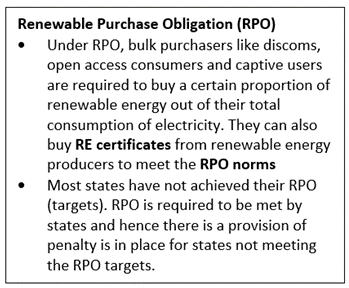Tuesday, 29th June 2021
Government stimulus post second COVID wave
In News
The Finance Minister of India announced some fresh relief measures for the economy, the first such package after the second COVID-19 wave
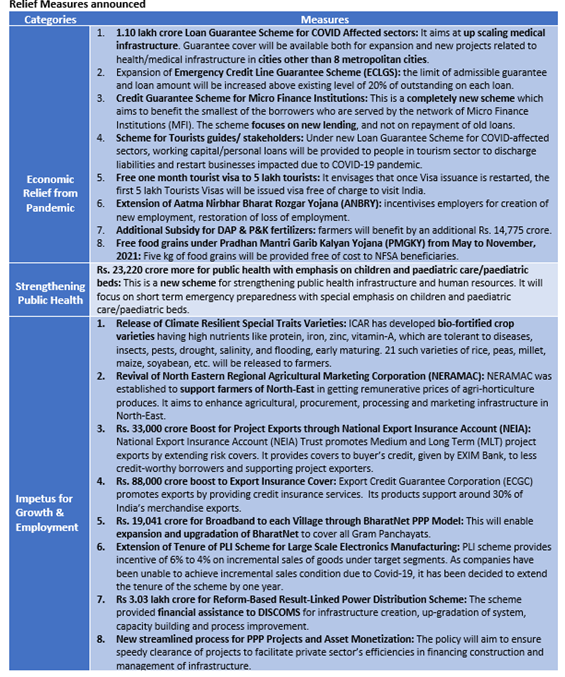
Source: https://pib. gov.in/PressReleasePage.aspx?PRID=1730963
Debt at 58.8% of GDP as economy contracts
In News
The Union government's debt soared to 58.8% of the GDP in the fiscal year ended March from 51.6% a year ago.

About the News
- As per the finance ministry data, the government debt increased as the economic contraction forced the government to borrow a record amount to meet a revenue shortfall.
- Factors of Contraction: The fiscal deficit widened to 2% of GDP in FY21 from 4.6% of GDP a year ago as revenue receipts contracted 3%, with the economy shrinking 7.3%.
- The contraction, the steepest in independent India, is ascribed to the disruption in economic activities caused by the first wave of the pandemic.
- Views of the Fifteenth Finance Commission (FFC): As per the FFC, the fiscal uncertainty is now at an all-time high amid Covid. This upward pressure due to contraction in government revenues is unavoidable when growth destruction must be mitigated, and income support extended.
- The general government debt, including states and Centre’s debt, may have crossed 90% in FY21. The FFC has recommended a slow and gradual decline in central government and general government debt to 56.6% and 85.7% (of GDP), respectively, by FY26 due to adverse debt dynamics over the next few years.
- Possible Effects of High Debt to GDP ratio: The longer the period of relatively subdued growth, the more likely it is that India’s debt burden will continue to rise. Further contingent liabilities for the government, in the event of renewed financial support to financial institutions would also add to the debt burden.
What is Debt to GDP Ratio?
- Meaning: It is the metric comparing a country's public debt to its gross domestic product (GDP). By comparing what a country owes with what it produces, the debt-to-GDP ratio reliably indicates that particular country’s ability to pay back its debts. Often expressed as a percentage, this ratio can also be interpreted as the number of years needed to pay back debt, if GDP is dedicated entirely to debt repayment.
- Variables: The Union government debt includes the stock of total liabilities due to internal debt raised through treasury bills, bonds and securities; external debt mainly raised from multilateral institutions; and public account liabilities such as provident fund commitments and National Small Savings Fund.
- Target value: The Fiscal Responsibility and Budget Management (FRBM) Act, as amended in 2008, mandated the debt-to-GDP ratio to serve as the medium-term anchor for fiscal policy, with the fiscal deficit as the operational target. It mandated the debt-to-GDP ratio of the Centre to be brought down to 40% and that of states to 20% by 2024-25. FFC has recommended setting up an FRBM review panel to draft a new fiscal consolidation framework because the current challenges have made the earlier targets impossible to achieve.
Sources: https://www.livemint.com/economy/debt-at-58-8-of-gdp-as-economy-shrinks-11624818421328.html
Link between Air Quality and Covid 19 Pandemic
In News
A pan-India study has established a link between fine particulate matter (PM2.5) zones and spread of COVID-19 virus. The research holds anthropogenic emissions responsible for increased infections in the areas with high PM content.
Key Observations of the Study
- The study observed that the regions using huge amounts of fossil fuels such as petrol, diesel, and coal by combustion in transport and industrial activities have experienced a higher number of Covid-19 cases.
- State like Maharashtra, Uttar Pradesh, Delhi, and Gujarat, with prolonged exposure to high concentration of PM2.5 exists, are among covid-19 hotspots.
- The novel coronavirus sticks to fine particleslike PM2.5 allowing them to move from one place to another, thus making airborne transmission of Covid-19 easy.
- The study was conducted by scientists from Indian Institute of Tropical Meteorology (IITM), Pune; NIT, Rourkela; IIT, Bhubaneswar, etc. It was partially funded by the Ministry of Earth Sciences, the Government of India.
Possible Solutions
- The study will help in slowing down the spread of the virusby providing more preventive steps and resources in areas with high pollution levels.
- There is a need to adopt cleaner technology, better transport emissionnorms like Bharat Stage (BS) VI, ensure better coal technology like ultra-supercritical power plants to reduce particulate emissions.
What is PM 2.5?
- Fine particulate matter (PM 2.5) is an air pollutant that is5 microns or smaller in size.
- These particles are formed due to burning fuel, industrial activities, chemical reactionsthat take place in the atmosphere, forest fires, etc.
- They reduce visibility of road/air traffic. Exposure to such fine particles can cause health issues like asthma, heart disease, etc.
Primary source: https://www.hindustantimes.com/cities/mumbai-news/cross-country-study-finds-link-between-air-pollution-and-covid19-101624645315485.html
Gross Environment Product (GEP)
In News
Uttarakhand announced to take into account ‘Gross Environment Product’(GEP) while calculating its gross domestic product (GDP).
More about the news
- Uttarakhand is set to become the first state in the country to assign monetary value to four of its critical natural resources -- air, water, forest and soil.
- The quality and quantity of these natural resources would determine the GEP of the state.
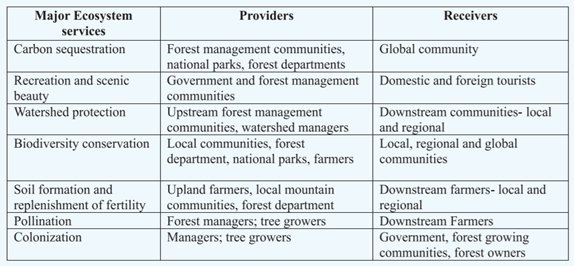
Introduction – Need for GEP
- Humankind benefits from a multitude of resources and processes that are supplied by ecosystem, collectively termed as “Ecosystem Services”. They include all the tangible and non-tangible assets or products which human get from nature like food, recreation, clean water, air and processes such as decomposition of wastes.
- "Ecosystem services" is a reflective of the complex connections between the natural environment and human wellbeing. It is primarily based on the impact of changes in the supply of ecosystem services and programs to increase their supply on near-term growth of GDP.
- There is a fundamental relationship between environmental protection and economic growth. This can make policymakers reluctant to support environmental protection.
- The economic concepts of GDP, GNP or per capita income do not reflect the correct state of economic development of a State or Country as these concepts do not reflect on the status of environment of the State/country impacted by economic growth.
- Moreover, we do not have a widely used indicator to measure ecosystems contribution to human well-being. They are positive externalities that are therefore regarded by the beneficiaries as free. As a result, many ecosystem services tend to be both under-conserved and undervalued.
- The loss and degradation of ecosystem assets has raised widespread concern about the resilience and sustainability of ecosystem services and the consequent threat to the economic activity and human well-being.
- GEP seeks to fill these gaps in current economic growth accounting mechanism while simultaneously providing sustainable development path. It seeks to “get the incentives right” by capturing the positive externalities, by providing accurate signals to both service providers and users that reflect the real social benefits that ecosystem services deliver.
About GEP
- GEP is the measure of ecosystem services of any area. GEP reflects the aggregated annual value of goods and services provided by ecosystems (forests, water bodies, oceans, etc.) to people in a given region, such as at district levels, state and country.
- GEP entails establishment of a natural capital accounting framework by integrating ecological benefits into common measures of economic growth such as GDP.
- GEP summarizes the value of ecosystem services in a single monetary metric. For instance, total value of forest ecosystem services flowing from Uttarakhand is about $2.4 billion / year. At the Indian Himalayan-level, it is Rs 94,300 crore / year.
- In some cases, the GEP could be more than the GDP. E.g., GEP was greater than GDP in Qinghai (China) in 2000 and was three-fourths as large as GDP in 2015.
Advantages of GEP
- GEP can be applied as a quantitative indicator for officials’ performance appraisal and auditing.

- GEP can be applied as a scientific basis for PES/Eco-Compensation and public financial transfers. E.g., Finance Commission’s revenue sharing formula between the Union and the states including forest cover as a determining factor in a state’s share.
- GEP can be applied to measure the status of ecosystem services, which is an important indicator of sustainable development. It is also a critical indicator for measuring the progress of Eco-civilization.
- The implementation of the concept and calculation of the GEP will let us understand the impact of anthropological pressure on our ecosystem and natural resources- air, water, soil, forests. This will enable us to make policies which will allow sustainable development.
Bottlenecks in establishing ecosystem services as one of the key sectors of GDP
- Policy Gap - Lack of recognition of ecosystem services in economic decision-making, development planning & resource allocation-value of ecosystem services is either ignored or poorly understood.
- Market Gap - Inadequate or missing market for many ecosystems service.
- Institutional Failures - Insufficient compensation for ecosystem services.
- Knowledge gaps-challenges to provide economic value of ecosystem services, regulating, and supporting services.
Way Forward
- Biophysical and spatio-temporal dynamics needs to be kept in mind while quantifying and valuing ecosystem services.
- Ethical questions and social disparity should be kept in mind as priority area while valuing the Ecosystem services.
- Develop framework to understand the impact of climate change on ecosystem services.
- Develop non-market method to strengthen and evaluate Ecosystem Services. Stress should be given on intangible assets, skills and knowledge specially the cultural values.
- Measure of factors like, water, soil, forest, biodiversity, emissions, degradation, pollution, etc signifying quality of environment should be included in the green accounting.
Conclusion
GEP will act as a balance between ecology and economy. If Uttarakhand would be able to formulate the mechanisms for a concrete GEP, then pressure on other states to do the same will also increase. However, there is a need for real-time data to better understand GEP. It is on the basis of this data that a future for the GEP could be determined.
Question: What is Gross Environment Product? Explain its utility in the economic system?
Primary Reference
https://hesco.in/gross-environmental-product.html
https://www.youtube.com/watch?v=rcpRBVrVQ0Q
https://seea.un.org/sites/seea.un.org/files/1._gross_ecosystem_product_and_ecological_assets_0.pdf
Secondary References
https://seea.un.org/sites/seea.un.org/files/1._gross_ecosystem_product_and_ecological_assets_0.pdf
https://seea.un.org/sites/seea.un.org/files/1._gross_ecosystem_product_and_ecological_assets_0.pdf
https://www.pnas.org/content/117/25/14593
https://www.iucn.org/asia/countries/china/gross-ecosystem-product-gep%EF%BC%89
This Day in History -National Statistics Day
India observes June 29 as National Statistics Day on the birth anniversary of PC Mahalanobis, often referred to as the 'father of Indian statistics'. PC Mahalanobis was born on June 29, 1893, in Calcutta, West Bengal. He was a key member of the first Planning Commission of independent India and a Padma Vibhushan awardee. The first National Statistics Day was observed on June 29, 2006. The key contribution of PC Mahalanobis is known as "Mahalanobis distance'. The formula is used to find the distance between a point and a distribution, based on measurements in multiple dimensions. It is widely used in the field of cluster analysis and classification.
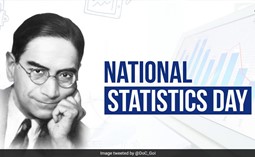
Image of the Day- Zen Garden, Ahmedabad
This is the image of Japanese-style Zen Garden in Ahmedabad that was recently inaugurated by the Prime Minister of India. The garden and a meditation centre have been set up at the Ahmedabad Management Association (AMA). Zen is defined as a school of Mahayana Buddhism, and it lies at the core of Japanese culture. The Zen Garden represents yin and yang, wind, and water - two elements that connect the Earth and the sky. The garden is built in a joint endeavour of the Japan Information and Study Centre at AMA and Indo-Japan Friendship Association (IJFA), Gujarat.

Terms and Concepts Project Seabird: INS Kadamba
- Context: inspection of Karwar Naval Base, Karnatakaand review of the ongoing infrastructure development under Phase-II of ‘Project Seabird’.
- Project Seabird involves construction of the largest naval base at Karwar.
- Phase I, completed in 2005, comprised construction of a deep-sea harbour, breakwaters dredging, a township, a naval hospital, a dockyard uplift centre and a shiplift.
- Phase-II envisages expanding facilities to house additional warships and set up a new Naval Air Station.
- INS Kadamba (Karwar) is currently the third-largest Indian naval base and is expected to become the largest naval base in the eastern hemisphere after completion of expansion Phase II.
- The Navy’s lone aircraft carrier INS Vikramaditya is based at Karwar. The base also has the India’s first sealift facility, a unique shiplift and transfer system for docking and undocking ships and submarines.
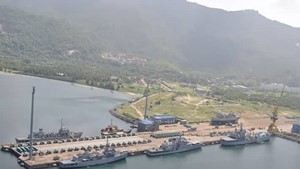
Primary source: https://www.thehindu.com/news/national/rajnath-singh-begins-visit-to-karwar-naval-base-kochi/article34944019.ece
Picture source: https://newsable.asianetnews.com/karnataka/project-seabird-in-karwar-put-on-high-alert-after-three-suspects-infiltrate-into-it
Bankim Chandra Chattopadhyay
- Context: his birth anniversary.
- He was a Bengali novelist, poet and journalist born on June 27, 1838, in West Bengal.
- He had authored the Anandamath- a political novel which depicts a Sanyasi rebellion (1770-1820) against the East India Company (published in 1882) He composed the song Vande Mataram in Sanskrit, which was a source of inspiration to the people in their freedom struggle.
- Bankim was the first person to hail Rabindranath Tagore as Viswakavi (Universal Poet).
- He founded Bangadarshan, a monthly Bengali literary magazine 1972.
- Bankim retired as a civil servant in 1891.

Picture source: https://twitter.com/incindia/status/1144110572293767168
China becomes Second Largest Export Partner
- Context: China has replaced the UAE as the second largest export destination for India in fiscal year 2020-21.
- Exports to China have jumped an impressive 28% in FY 21 from a year before to over $ 21 billion with China’s massive infrastructure push prompted it to import iron ore and steel in large volumes from India.
- China’s share in India’s export basket rose to 7.29% in FY21 from 5.3% the year before.
- The US remained the India’s top export partner, according to government data, but shipments have declined 2.78% to $51.63 billion when India’s merchandise trade- both exports and imports have fallen amid global lockdowns and disruption to logistics due to the pandemic.
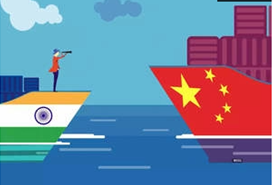
Primary source: https://economictimes.indiatimes.com/news/economy/foreign-trade/china-is-now-second-largest-export-partner-of-india/articleshow/83851116.cms
Picture source: https://economictimes.indiatimes.com/news/economy/foreign-trade/china-is-now-second-largest-export-partner-of-india/articleshow/83851116.cms
Hypersonic Missiles
- Context: China, Russia and the United States are pursuing hypersonic weapons technologies, setting the stage for another arms race.
- Hypersonic missiles are those missiles which fly through the atmosphere at more than five times the speed of sound (6,115 km per hour), much faster than other ballistic and cruise missiles and can deliver conventional or nuclear payloads within minutes. This makes them fast, less detectable, and less intercept-able.
- They are highly manoeuvrable and do not follow a predictable arc as they travel.

Primary source: https://spectrum.ieee.org/tech-talk/aerospace/military/hypersonic-missiles-are-being-hyped
Picture source: https://www.sandboxx.us/blog/what-exactly-are-hypersonic-missiles-and-why-do-they-matter/
What India can learn from China’s evolving foreign policy- IE
Essence: Mr. C Raja Mohan is providing insights into factors responsible in Chinese quantum leap of progress & lessons for India. Different set of internal and external circumstances had a great impact on their evolution.
India, which joined hands with China in the 1990s (despite the debacle of the 1950s), to promote a “multipolar” world, now finds itself squeezed by Chinese power on multiple fronts — from the Great Himalayas to the Indian Ocean and from regional to international institutions. China did not let internationalism come in the way of its national ambition. For any nation, large or small, internationalism cannot be an end in itself; it is a critical instrument in strengthening national unity, security, and prosperity. There is much that India can learn from China on building flexible global coalitions, adapting quickly to changing internal needs and external circumstances.
Why you should read this article?
- To gain understanding on India China growth trajectory.
- To understand the link between political decision making & wider implications on nation’s future.
- It is also providing insights into China’s balancing between Nationalism & Internationalism, and learnings here.
Article Link: https://indianexpress.com/article/opinion/columns/what-india-can-learn-from-chinas-evolving-foreign-policy/
E-commerce: Excessive regulations can undermine the sector’s growth potential- HT
Essence: In past few years, numerous regulations have been proposed to regulate the e-commerce sector along with some clarifications of foreign direct investment (FDI) norms and the draft Personal Data Protection Bill. We need self-regulation in place of statutory regulations in this sector. Recently, proposed amendments to govern e-commerce under the Consumer Protection Act seem to have an overlap with existing regulations under FDI norms and Competition Law and may create a licensing regime for the sector, limiting the competition and affecting the consumers. Government needs to create an ecosystem that helps the sector thrive by doing away with unnecessary compliance requirements and encourage technology adoption.
Why you should read this article?
- To get an overview of e-commerce sector in India and what are some major issues they are facing.
- To know the possible steps government should take to tackle the same.
Keeping Mongolia Green
Background:
- Tujiin Nars, 350km north of the Mongolian capital Ulaanbataar, is a vast pine tree forest.
- A large forest fire in 1998 consumed 32,600 hectare of the forest. Other reasons like illegal logging, pest infestation ripped out another 10,000 hectare.
- To undo the loss of forest, Yuhan Kimberly Limited successfully planted 1 crore trees of Scots pine in an area of 3,250 hectare over the span of 12 years from 2003 and 2014
Outcome:
- Restoration of the entire ecosystem: The forest created served as a valuable habitat for wildflowers, birds, wolves, and bears
- Improvement in supporting ecosystem service via improvement in soil nutrients and water retention
- Improved regulating service as it leads to better carbon sequestration.
- Environmental education: Tujiin Nars has become hands-on ecological education for school students leading to environmental sensitization.
Where can this case study be used:
- As an example of best practise for restoration of forest, social forestry, ecosystem services improvement via restoration of forest.
Things to Ponder:
- What is the percentage of forest in India?
- What is the national target of land that should be under forest as per Forest Policy of 1988.
Source: https://www.unccd.int/actionsland-life-programme/land-life-award-2021-healthy-land-healthy-lives
Share the article
Get Latest Updates on Offers, Event dates, and free Mentorship sessions.

Get in touch with our Expert Academic Counsellors 👋
FAQs
UPSC Daily Current Affairs focuses on learning current events on a daily basis. An aspirant needs to study regular and updated information about current events, news, and relevant topics that are important for UPSC aspirants. It covers national and international affairs, government policies, socio-economic issues, science and technology advancements, and more.
UPSC Daily Current Affairs provides aspirants with a concise and comprehensive overview of the latest happenings and developments across various fields. It helps aspirants stay updated with current affairs and provides them with valuable insights and analysis, which are essential for answering questions in the UPSC examinations. It enhances their knowledge, analytical skills, and ability to connect current affairs with the UPSC syllabus.
UPSC Daily Current Affairs covers a wide range of topics, including politics, economics, science and technology, environment, social issues, governance, international relations, and more. It offers news summaries, in-depth analyses, editorials, opinion pieces, and relevant study materials. It also provides practice questions and quizzes to help aspirants test their understanding of current affairs.
Edukemy's UPSC Daily Current Affairs can be accessed through:
- UPSC Daily Current Affairs can be accessed through Current Affairs tab at the top of the Main Page of Edukemy.
- Edukemy Mobile app: The Daily Current Affairs can also be access through Edukemy Mobile App.
- Social media: Follow Edukemy’s official social media accounts or pages that provide UPSC Daily Current Affairs updates, including Facebook, Twitter, or Telegram channels.


